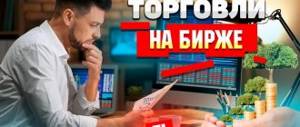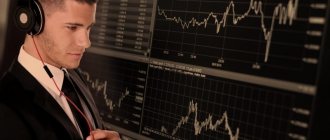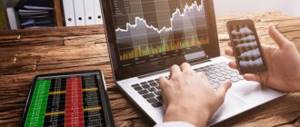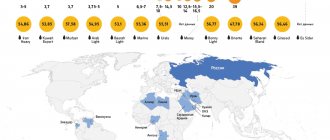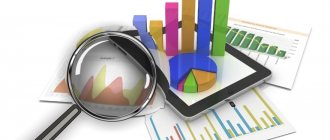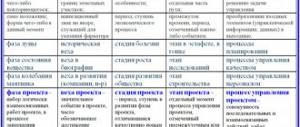How to start trading Forex and where to get lessons for dummies? How to work with the trading platform for beginner traders MetaTrader4? Where should you start analyzing the Forex market?
Hello, dear readers! This is the author of the HeatBober website, Alexey Morozov. We continue our acquaintance with the Forex market, today we will talk about the basic knowledge necessary for trading.
I have successfully traded on the Forex exchange with the largest Russian brokers for several years. Based on my own experience and conversations with professional traders, I can confidently say that without awareness of the material below, trading is simply impossible.
So let's get started!
Where to trade? Which broker do you recommend?
The question that is asked most often. Unfortunately, there are a lot of scams among Forex brokers. Therefore, choosing a reliable broker is very important. Personally, my main trading accounts are opened with Alpari. The company is old and reliable (providing services since 1998), with a good reputation. There are no problems with output, they work correctly.
Also, using our broker selection service, you can choose the company that is right for you.
When choosing a broker, it is important to carefully consider the following criteria:
- Reputation and quality of work (order execution, slippage)
- Terms of trade (the lower the costs, the more you earn)
- Support (it is important that you can answer any questions you have, especially at the initial stage)
- Software (possibility of using the application on the phone)
- Security (important, conditions for depositing and withdrawing funds, identity verification procedure)
I would advise starting with an amount of at least $100, otherwise you may simply not have enough funds in your account if there is a small drawdown, without which trading is impossible.
How to work in the MetaTrader4 trading platform - 8 simple steps
Many companies are trying to create their own platforms, but so far nothing better has been invented in comparison with MetaTrader. Following eight simple steps will give you the most complete understanding of this program.
We will return to MetaTrader in other articles, for example, in “Exchange Trading for Beginners,” so the material presented below must be studied carefully.
Step 1. Download the platform
MT4 must be downloaded on the website of the broker with whom you plan to cooperate: the set of financial instruments and some minor parameters differ.
Installation is straightforward - the program is downloaded to drive C and opens automatically.
Step 2. Log in
Usually the terminal itself displays an authorization window. If this does not happen, click on “Connection Status” in the lower right corner and click “Login”:
A trading account, as a rule, is opened on the broker’s website - you receive a password and a server, and connect to it.
If authorization is successful, you will see the amount of money in your account on the display and you will be able to open real transactions. We have 101.32 dollars as an example:
Step 3. Create a template and set up charts
To trade successfully, we will bring the charts into the desired form and remove all unnecessary things. At first, only four currency pairs are available, but you can open new ones without any problems.
To configure the graph, right-click on it, select “Properties” or simply press F8. A window opens with two tabs, the first is “Colors”. Here we change the color scheme to “Black on White”:
Now in the “General” tab we put the necessary checkboxes and remove the unnecessary ones as in the screenshot below:
Great, we have successfully set up the schedule! In order not to carry out this procedure with each currency pair, we right-click on the chart and select “Template” - “Save Template”:
We save to the folder that opens (for us it’s Templates). Now, to set up a new chart, you just need to select the saved one in the list of templates and click on it.
Step 4. Install indicators
We talked in detail about installing indicators in the previous article. Let us repeat: to install the program, you need to select it in the “Navigator”, drag it onto the chart and configure the parameters.
Step 5. Set up alerts
Sound notifications or alerts will significantly improve your trading - when the price reaches a certain level, you will hear a signal that will be repeated periodically.
To configure, right-click in the desired place on the chart and select “Trading” - “Alert”:
After clicking, a red arrow will immediately appear on the screen; when the price touches it, a signal will sound. If the notification is activated by a mouse click, then in the settings window you only need to change the timeout and the number of repetitions:
“Timeout” is the time period after which the signal will be repeated, the minimum value is 10 seconds, “maximum repetitions” is the number of times the alert will make itself known.
Step 6. Determine the trend
In almost any strategy you need to determine the trend. This can be done either using an indicator or the “Drawing a trend line” tool - connecting each top and bottom:
After trading for several days, a beginner gets the hang of it and determines the trend simply by looking at it, but at first it can be a little difficult. In the figure and above, both trend lines and the MA indicator helped us in determining the trend.
Step 7. Open a new order
To open a deal, click “Open order” on the toolbar, or press F9, or double-click on the chart. The window looks like this:
The lot is indicated depending on the capital (more on this in other articles). Stop Loss and Take Profit must be written immediately at the moment of opening a position; at what level depends on the trading strategy.
When the order is opened, trading begins - we will see the profit or loss online on the board.
This concludes our brief tour of the MT4 terminal, but we will return to certain points in other texts.
Where to even start?
From the beginning, from the basics. Take a look at the introductory Forex course for Beginners , many questions will disappear. If you don’t understand a term, you can always find out its meaning in a special dictionary.
To work, it is enough to have a computer and the Internet to be able to work at home.
Whether it is worth taking a Forex training course or learning all the intricacies of trading on your own is up to you. But I would still recommend taking the course.
Is it possible for a beginner to make money on Forex?
There is a prejudice that only professionals who have completed many years of practical school make money in Forex. The best answer to this will be the achievements of novice traders who have proven their “professional suitability” in the famous experiment of R. Dennis, described in detail in the book by K. Feis “The Way of the Turtles”.
The results of trading amateurs proved that the absence or presence of past experience does not have a decisive influence (the participants in the experiment completed only a basic training course).
How much can you lift?
You shouldn’t fall into euphoria and count on the mythical 1000% profits that some brokerage houses in the forex market talk about (you can’t call them companies).
The real earnings of successful Forex traders can reach up to 100% per annum, but beginners are better off focusing on other indicators: the main thing is to maintain a positive balance of profitable and unprofitable transactions.
Staying afloat, you can think about increasing profitability by adding new forecasting tools and improving proven trading strategies.
How long does it take to learn how to make money on the stock exchange?
The question of the time it will take to master the basics of trading on Forex depends on the individual characteristics of the trader, the intensity and methods of preparation (self-training, on-site courses, remote training).
As a rule, “school theory” can be mastered in a couple of months; another month will be spent on practical testing of knowledge and skills (variants of demo and/or micro accounts).
I want to trade. Cut the loot, loot!
First of all, don't rush. Forex is very difficult for beginners. The market will not run away from you. First, you should decide what you want: trade independently or transfer funds to management.
Do not forget that high risk arises from lack of knowledge, practice and improper money management. Forex is difficult for those who do not invest some time in learning the basics. Before looking for quick and easy money, you must improve your understanding of the market.
Who is an investor and what does he do?
The concept of “investor” unites legal entities and individuals who invest capital in the purchase of assets or projects to generate additional income.
United by a single ultimate goal, investors have different approaches to achieving it and are conditionally divided into “conservatives” (purchase low-risk assets for the long term) and “speculators” (a striking example is Forex traders).
How investors work
Investment methods depend on a number of factors:
- amount of free capital;
- level of financial literacy;
- acceptable time intervals;
- assets used.
The technical execution of investment deposits (be they securities, shares in projects or currency speculation) is carried out in most cases on stock exchanges, through brokers. You can do without intermediaries when it comes to bank deposits or the acquisition of real material assets (precious metal bars, coins, etc.).
How much do investors earn?
If the main objective of an investment is to preserve funds (inflationary losses are taken into account), then the level of profitability is focused on this indicator.
Such investors will not speculate on exchange rates or buy junk stocks. The goals of aggressive investment strategies are aimed at significant capital growth and can be several times higher than the return on conservative investments.
Discarding “advertising provocations” about super-profits, you can focus on an average annual income of 5 to 50%.
Dividends on shares
One of the common types of investments is the purchase of shares not for the purpose of resale, but with the expectation of receiving dividends on them. In fact, the investor becomes a shareholder of the company and takes part in the distribution of its profits (in the part allocated for dividend payments).
The level of return will depend on the degree of risk and duration of investment.
Shares of “blue chips” (for example, Gazprom, Norilsk Nickel, Sberbank) are reliable, but grow slowly (yield can range from 4 to 8%), while the acquisition of “junk” shares (little-known companies) is associated with high risk, but they can bring in the future significantly larger dividend payments (from 8 to 20%).
Government bonds
One of the investment instruments in Russia, which occupies an intermediate position in terms of profitability between bank deposits and exchange-traded financial assets, is OFZ government securities (federal loan bonds).
The purchase of OFZs for individuals has become possible since 2021. The government acts as the guarantor of OFZs (the issue is carried out by the Ministry of Finance). OFZ are traded in rubles on the Moscow Exchange (yield from 4 to 7%).
How to choose OFZ for investment
The selection of OFZ depends on the priorities in terms of investment terms, as well as on the type of coupon (divided according to the method of percentage calculation and indexation of the inflation rate).
Interest in this tool is due to:
- Availability - the value of one coupon is 1000 rubles.
- Liquidity – high demand for purchases.
- Wide choice - there are 41 OFZ options (divided by cost and maturity date).
- Low risks - OFZs are backed by government guarantees.
Let's say I want to invest. What's next?
There is a wonderful service for PAMM accounts. You can read what it is here.
The rating of PAMM account managers is available at
https://alpari.finance/ru/invest/pamm/
PAMM account is an account management system through which both traders and investors can make profits. Investors trust their funds to be managed by experienced and successful traders by investing in PAMM accounts. Traders, using the capital of interested investors, make profitable transactions, increasing investor capital and receiving management fees.
You do not need to trade Forex yourself - you constantly monitor the work of the manager and can withdraw your funds at any time.
In addition, every month we publish an “Investor Digest”, where we monitor the most interesting projects for investment.
Who is a trader and what does he do?
Trader translated from English is a trader. It is precisely trading that these people do, not just standing at counters with goods, but conducting purchase/sale transactions on specialized financial platforms - exchanges.
The trader’s task, at first glance, is simple - to make money on the difference in the value of a financial asset (currency pairs, stocks, indices, precious metals, raw materials, etc.). In fact, such speculation requires the presence of many qualities - both innate and acquired.
Today, the profession of a trader is one of the most prestigious and profitable (not a bad combination).
How does a trader work?
Traders practice different work options, which depend on their level of qualifications, availability of equity capital, and individual psychological characteristics.
Working for yourself
Most traders prefer to work independently, taking upon themselves all the benefits, burdens and adversities.
Newcomers to forex start in different ways:
- immediately set off on their own;
- become members of a trading team.
Team trading on Forex has its advantages:
- the combined capital allows you to trade with a large deposit (risks are reduced, a wide range of strategies is used);
- team analytics is much more effective;
- the emotional component of bidding is compensated by collective support;
- costs for equipping a trader’s workplace are minimized.
Working for a company
Professional traders who are able to prove their level with real profitable accounts can apply to work under the “umbrella” of market makers.
Large financial structures attract such specialists on a regular salary and negotiate bonuses in the form of a percentage of profitable forex transactions.
Qualities required to work as a trader
The basic rule that any novice trader must learn is that stock trading on Forex brings profit only to those who treat this activity as a profession.
History knows many examples when mathematicians and economists (kindred spirits for mastering technical and fundamental analysis) achieved outstanding success in trading.
But the lucky ones also included a contingent that was far from knowledge of higher mathematics and macroeconomic indicators - doctors, psychologists and even housewives. Everyone had one thing in common - a professional attitude towards the new business.
Summarizing the characteristics of different groups of successful forex traders, experts identified a set of qualities that a trader should have:
- analytical thinking;
- intuition;
- introspection;
- stress resistance (the ability to withstand high emotional stress).
How much can a trader earn?
As I already mentioned, the real profitability of a trader on the forex market on average fluctuates around 100% per annum.
The level of profitability of forex transactions depends on:
- lot size (standard volume 100,000 USD);
- leverage (from 1:10 to 1:1000);
- the strategy used (intraday, medium-term, long-term);
- degree of volatility of the selected financial asset.
Let's say I want to trade on my own. What to do?
Experience shows that learning to trade Forex so that trading brings in about 5-10% per month is not so difficult. It is difficult to maintain self-control and discipline, not to give free rein to emotions and to follow the rules.
First of all, download and install the Metatrader 4 terminal.
Again, you have a choice: trade manually or automatically with the help of advisors (programs that trade for you on autopilot).
Whatever you choose: automatic or manual trading, be sure to study Money Management!!! This is extremely important!!!
If you want to use advisors, I recommend taking a look at the Advisors section.
When working with advisors (trading experts), you will certainly find the Forex video course on Autopilot useful.
What earnings depend on - 5 important factors influencing a trader’s income
Making money on the Internet is fraught with risk, but there are factors that allow you to increase your profit to $1,000 in just 3 months when you deposit $500 into your account.
Factor 1. Competent choice of trading strategy
We are talking about short-term trading.
This is a style of trading where trades are opened and closed within 1-2 days. It is also called intraday trading. Here we use charts that consist of bars up to 1 hour. Additionally, this type of trading includes scalping (short-term holding of positions with a profit rate of several ticks). Medium-term trading involves using less leverage than, for example, the same intraday trading. This is due to the fact that the ranges of value movement in each position that is open are much larger. And if you use high leverage, then there is a high risk of closing the transaction on a margin call (the broker's requirement that the client deposit additional collateral into his account). This strategy is recommended by experts.
Factor 2. Strategy effectiveness
It is recommended to choose Trading Made Simple for a number of reasons, such as:
- Brings 65-75% positive transactions on a regular basis.
- Shows excellent trading results after midnight.
- Uses 3 indicators to confirm entry.
- Minimizes the presence of a trader near the monitor.
- Best suited for medium-term trading.
- Good entry points at the beginning of the European and American trading sessions.
Factor 3. Volatility level
We are talking about a statistical financial indicator characterized by price variability. Expected volatility includes its current performance and projected changes in risks in the future. Various factors influencing the cost are added to the calculation of the expected financial indicator.
Factor 4. Amount of capital invested in the account
Money management is the ability to make a profit, even if the number of unprofitable and profitable transactions is almost the same.
Therefore, it is important to carefully familiarize yourself with its principles to achieve positive dynamics. Some sites offer not only instructions, but also an online money management calculator for calculating positions, allowing you to potentially determine profit and loss in advance.
Factor 5. Stress resistance
How to make money on Forex from scratch - the answer lies in increasing stress resistance, which requires a lot of work on yourself and personal development. In this case, the problem is not solved locally.
Stress resistance largely depends on the following personal characteristics:
- Locus of control. Conventionally, people are divided into 2 types: the first, in case of failures, look for their cause in the external influence of various factors, the second prefer to take responsibility for their lives upon themselves. It is important for a trader to learn to identify the reasons for failure in order to achieve good results in his work.
Self-esteem. Working on yourself, developing your skills and achieving goals is the basis for high self-esteem. And even if everything does not always go smoothly, the understanding that you did everything possible will not allow you to feel regrets and feel guilty.
You should seek help from a psychologist if you want to become a broker, but are aware of a low level of self-esteem and the inability to help yourself on your own.
What about manual trading?
The most important thing in manual trading is to follow the system. A Trading Strategies section was created especially for manual trading, which is constantly updated.
Independently conducting transactions on the Forex currency market provides many more opportunities. The higher the skill of a trader who prefers manual Forex trading, the larger volumes of money he can manage, and accordingly, the more he can earn. In most cases, approximate forecasting of price movements is not a difficult task; there are simple price models that work with efficiency of up to 90%. It is possible to find these models and learn how to use them.
Forex for dummies – basic terms and concepts
We will talk about Forex terminology throughout all articles devoted to this topic. Within the framework of this material, we will only cover the concepts of “trend”, “support and resistance” and some others.
You can get acquainted with these fundamental names in more depth in the material “How to play on the stock exchange”.
Most of the time, the foreign exchange market is in motion, which can go either up or down. Therefore, the first two types of trends: upward (also known as upward or bullish), downward (also known as downward or bearish).
For successful trading, remember the key definitions:
A bullish trend is observed when a new peak updates the previous one, and a new trough does not fall below the previous one.
In a downtrend the situation is reversed:
A bearish trend is observed when a new depression updates the previous one, and the new top does not rise higher than the previous one.
An example of a bullish trend that is apparently close to ending or has already ended:
Ended bearish trend:
Sometimes prices move in a “corridor”: they either rise or fall within certain limits. We wrote earlier that a similar situation is often observed for several days before planned important news.
“Corridor movement” is called a sideways trend (also known as horizontal or neutral). For this trend, it is important to remember the following:
A sideways trend is observed only when the amplitude of fluctuations is at least 300 points.
If this rule is not observed, trading should not be carried out under any circumstances. In the example below, we see a sideways trend with an amplitude of 158 points - not enough to open positions.
Let us summarize the above in table form:
| № | Trend | Synonyms | Direction | Special requirements |
| 1 | Rising | Bullish, upward | Up | None |
| 2 | Descending | Bearish, bearish | Down | None |
| 3 | Horizontal | Side, neutral | No direction | Amplitude of at least 300 points |
During the movement, prices rely on or are pushed away from invisible lines, which are called “support and resistance lines.” To carry them out, it is enough to connect the peaks or troughs.
If the price breaks through support or does not reach resistance, this is a signal of a weakening trend. If the price does not reach support or breaks through resistance, an acceleration signal:
The price on the screen above “confirmed” the support (yellow line), but did not touch the resistance (blue line) - the reversal signal was confirmed: the market did not update the top, and then broke through the support.
Let us remember one more very important point:
Transactions can only be opened in the direction of the trend - if it is upward - buy (Buy), if downward - sell (Sell)
These were the general principles of making money on Forex for a beginner, but everyone wants to become a professional, right?
What are some good trading books to read?
There are a huge number of books from famous authors that will teach you how to use technical methods to predict price movements in markets and successful financial transactions. The books are a basic guide to technical analysis of financial instruments. The literature is specialized for both novice players and experienced specialists in the exchange and over-the-counter markets.
see post Recommended reading
Promotions, bonuses, competitions
If you want to increase the amount of your funds by using the bonuses that brokers give when a trader funds an account, or even if you want to try your hand at trading without depositing your own funds at all, taking advantage of a no deposit bonus, then you can find brokers who provide all this in a special section of our rating.
Also, for each broker, we provide up-to-date information about current and upcoming competitions on real and demo accounts, where everyone can try their hand and test their trading skills, and as a reward receive a real cash reward or even valuable prizes, such as, for example, luxury sports cars .
Something else?
Browse the Beginners and Training sections - there you will find many useful instructions and tools on various aspects of Forex trading for beginners.
Some tips for beginners:
- Don't trade on a schedule - the decision must mature
- Determine your action scenario in advance
- Act with discipline
- Limit the amount of information
- Don't read a lot, read useful things,
- Don't mix trading with academic views,
Stay cool and calm.
Graphic tools for work
It is important for beginners to learn how to work with the graphical tools of the trading platform. In particular, you need to know that when drawing a trend line, it will by default have the shape of a ray. However, you can also make a segment. This requires a few simple steps: select Properties > Options > uncheck the box.
If you go to the “General” tab, you can select the thickness and shade of the segment. To change the slope, you can click on its extreme points. To get the same line in parallel, you can press CTRL and drag the line to the side.

